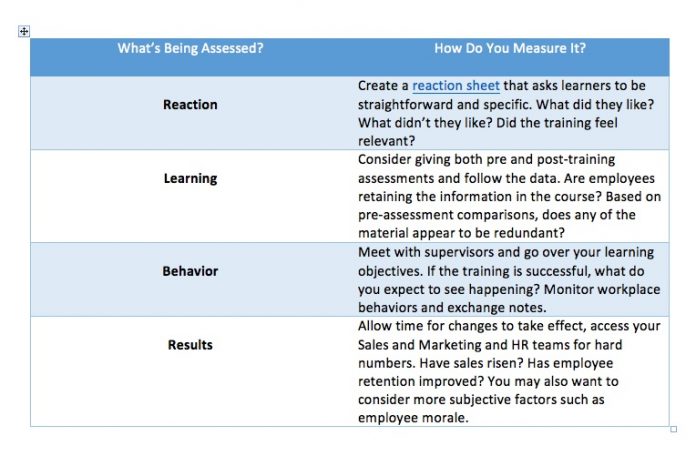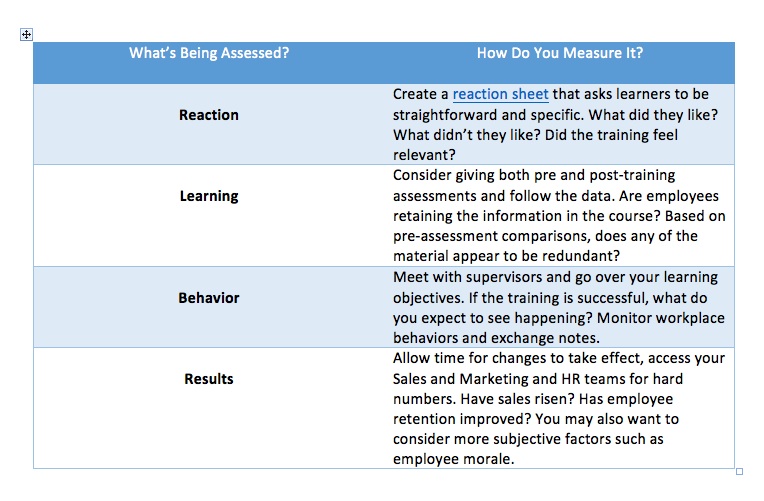
How do you know whether an instructor-led training (ILT) was effective? Was it worth the time and money your company invested? If it seems the answer would become obvious once employees returned to work, it’s often not. There are several factors to consider. Assuming participants did learn some new information, an employer still has to ask:
- Did they enjoy the training?
- Does the learning match up with what’s happening in the workplace?
- Will they have the motivation to alter long-standing habits?
- Will the training have an effect on the bottom line?
There are so many considerations to make when evaluating training or employee onboarding effectiveness (and it’s so important to do so!) that it helps to have a system in place specifically for that purpose. Employers, instructors, and learning designers will need to cooperate to develop an evaluation program specific to the organization’s needs.
A good starting point is the Kirkpatrick Model, which defines four levels of training value:
- Reaction: How do learners feel about the training?
- Learning: What new information and skills are the learners taking away?
- Behavior: Are the intended changes actually happening?
- Results: Did you achieve the desired outcomes for the company or organization?
Because organizations and instructional materials differ greatly, the Kirkpatrick Model is best understood as a template on which to build. Looking at each of the levels, it will be up to you to determine what outcomes to emphasize, when to use digital vs. paper and pencil solutions, and how to track data.
This process involves not only the classroom instructor, but other members of the organization who will be in a position to evaluate outcomes later on. Applying the Kirkpatrick Model is a collaborative effort! Here are some ideas for how to implement evaluation on each level:

The Kirkpatrick Model originally was designed for instructor-led trainings, and it remains clearly applicable in a classroom setting. At the same time, as ILTs and e-learning become increasingly integrated, e-learning offers additional possibilities for getting the most out of your evaluation. For example, if a hybrid classroom training communicates with systems such as SCORM or the Experience API, then it will be easier to track learner performance over time. Knowledge tests also can be integrated seamlessly throughout the course, rather than always taking the form of a pre- and post-assessment.
ILTs have the advantage of bringing the learner into the social, collaborative space of the classroom. As you develop an evaluation system for an increasingly personalized and digitized learning experience, it’s important to preserve the advantages of a social learning environment. To that end, here are two final tips to keep in mind when developing your training evaluation model:
- Focus on Engagement. Use your experience from previous trainings to determine which of the many possibilities—gamification, storytelling, focus groups—helps your learners to feel involved and excited. To see some examples of how classroom instructors have created a blended model using e-learning, click Here.
- Ensure Commitment. Learning has little impact if there’s no intention to apply it. Think about how you can ask learners to make a specific commitment, balancing the equation by offering appropriate incentives and rewards.
Instructor-led training remains a popular approach for many companies. With an increasing number of digital tools available for augmenting traditional classroom trainings, it is essential to evaluate what works and what doesn’t. The Kirkpatrick Model offers a flexible strategy for considering subjective features (learner enjoyment) alongside objective ones (performance data); combining analytics with workplace community; and adapting trainings based on ongoing performance.
Blake Beus is the director of Learning Services at Allen Communications, a global training company that helps companies improve employee engagement by creating custom training and learning solutions for all types of company training and employee development needs, including product and policy knowledge, safety, leadership, new hire help, and employee engagement training. For more information, visit http://www.allencomm.com.




